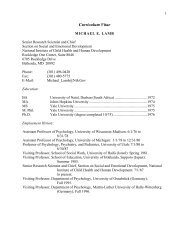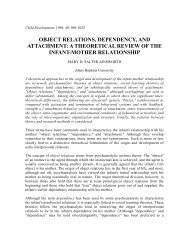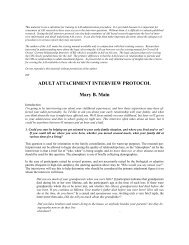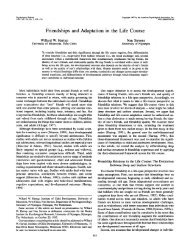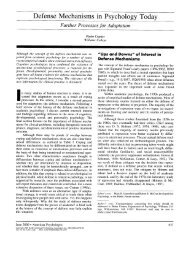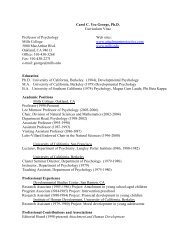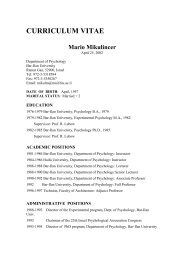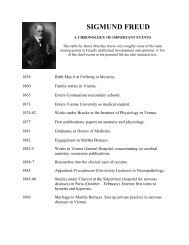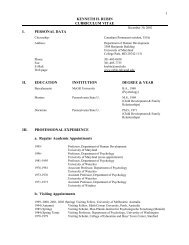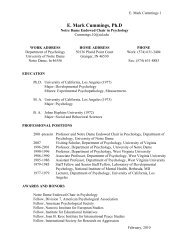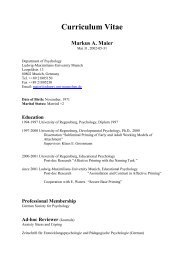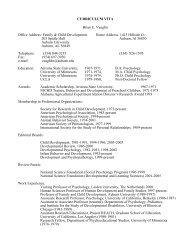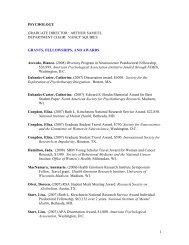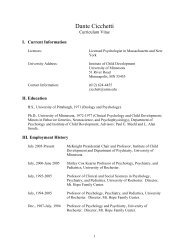the origins of attachment theory: john bowlby and mary ainsworth ...
the origins of attachment theory: john bowlby and mary ainsworth ...
the origins of attachment theory: john bowlby and mary ainsworth ...
Create successful ePaper yourself
Turn your PDF publications into a flip-book with our unique Google optimized e-Paper software.
eciprocal expectancies.<br />
Given that old patterns <strong>of</strong> action <strong>and</strong> thought guide selective attention <strong>and</strong> information<br />
processing in new situations, some distortion <strong>of</strong> incoming information is normal <strong>and</strong> unavoidable.<br />
The adequacy <strong>of</strong> internal working models can be seriously undermined, however, when defensive<br />
exclusion <strong>of</strong> information from awareness interferes with <strong>the</strong>ir updating in response to develop-<br />
mental <strong>and</strong> environmental change.<br />
To explain <strong>the</strong> workings <strong>of</strong> defensive processes, Bowlby cites evidence showing that<br />
incoming information normally undergoes many stages <strong>of</strong> processing before reaching awareness<br />
(see Dixon, 1971; Erdelyi, 1974) At every stage, some information is retained for fur<strong>the</strong>r<br />
processing <strong>and</strong> <strong>the</strong> remainder discarded. That this may happen even after information has already<br />
undergone very advanced levels <strong>of</strong> encoding is shown by dichotic listening studies, In <strong>the</strong>se<br />
studies, individuals who are presented with different messages to each ear through headphones<br />
are able to selectively attend to one <strong>of</strong> <strong>the</strong>m. That <strong>the</strong> unattended message is never<strong>the</strong>less<br />
receiving high level processing becomes obvious when <strong>the</strong> person becomes alerted to a word <strong>of</strong><br />
personal significance (e.g., <strong>the</strong> person’s name) that has been inserted into <strong>the</strong> unattended<br />
message.<br />
Bowlby proposes that defensive exclusion <strong>of</strong> information from awareness derives from <strong>the</strong><br />
same processes as selective exclusion, although <strong>the</strong> motivation for <strong>the</strong> two types <strong>of</strong> exclusion<br />
differs. Three situations are believed to render children particularly prone to engaging in defensive<br />
exclusion: situations that parents do not wish <strong>the</strong>ir children to know about even though <strong>the</strong><br />
children have witnessed <strong>the</strong>m, situations in which <strong>the</strong> children find <strong>the</strong> parents’ behavior too<br />
unbearable to think about, <strong>and</strong> situations in which children have done or thought about doing<br />
something <strong>of</strong> which <strong>the</strong>y are deeply ashamed.<br />
Although defensive exclusion protects <strong>the</strong> individual from experiencing unbearable mental<br />
pain, confusion, or conflict, it is hound to interfere with <strong>the</strong> accommodation <strong>of</strong> internal working<br />
models to external reality. Indeed, a number <strong>of</strong> clinical studies reviewed in Separation (e.g., Cain<br />
& Fast, 1972) suggest that defensive exclusion leads to a split in internal working models. One set<br />
<strong>of</strong> working models- accessible to awareness <strong>and</strong> discussion <strong>and</strong> based on what a child has been<br />
told-represents <strong>the</strong> parent as good <strong>and</strong> <strong>the</strong> parent’s rejecting behavior as caused by <strong>the</strong> “badness”



